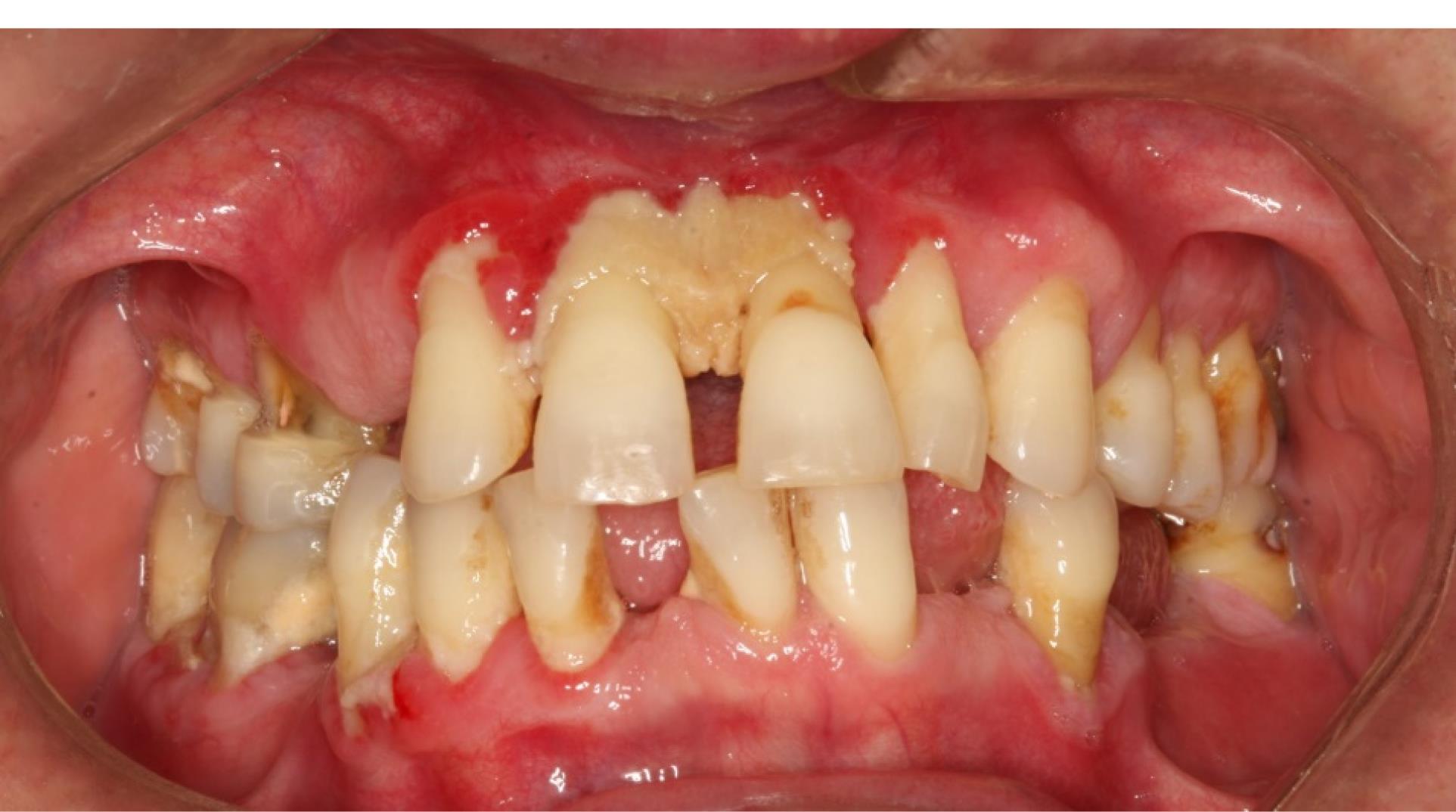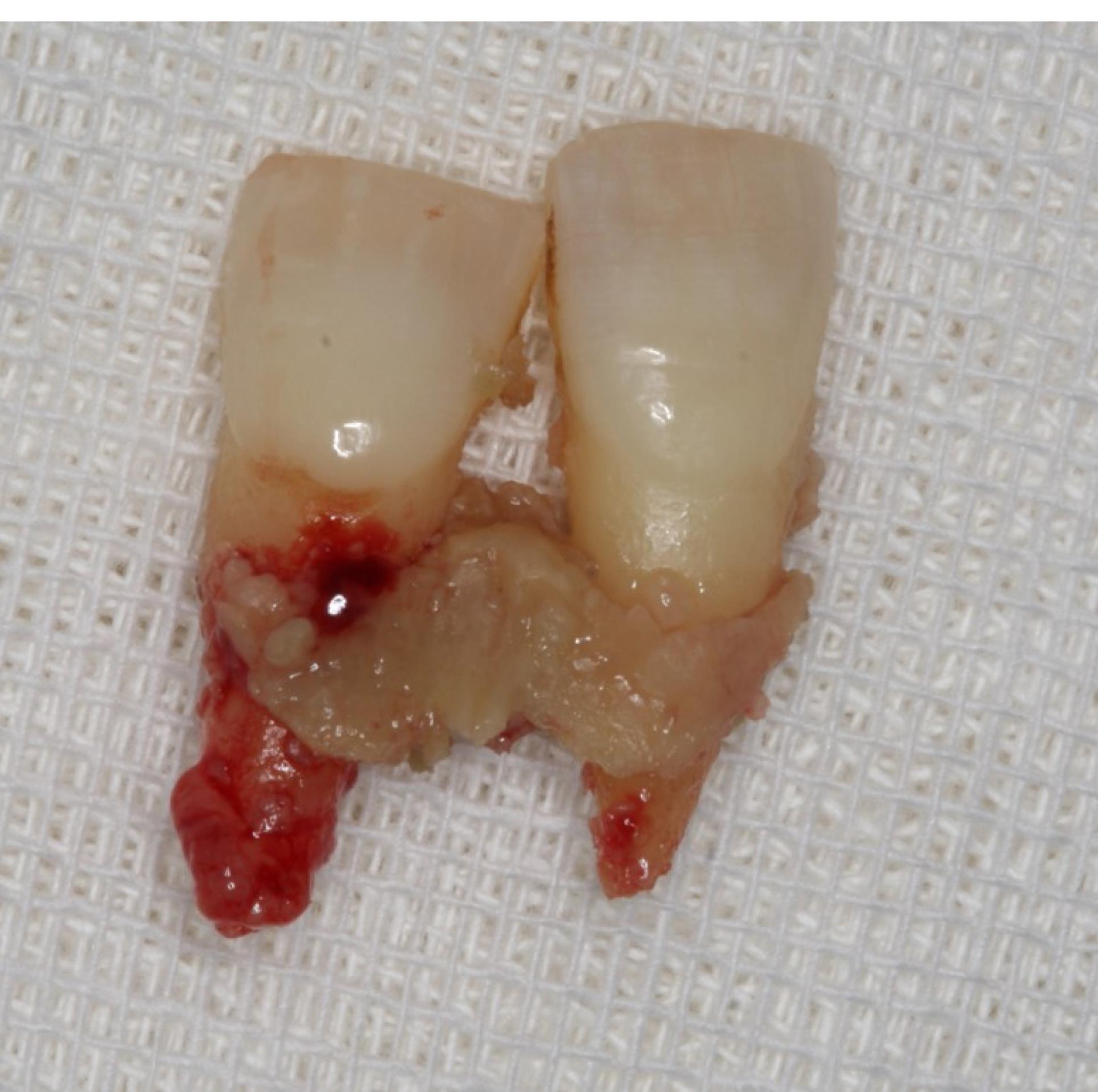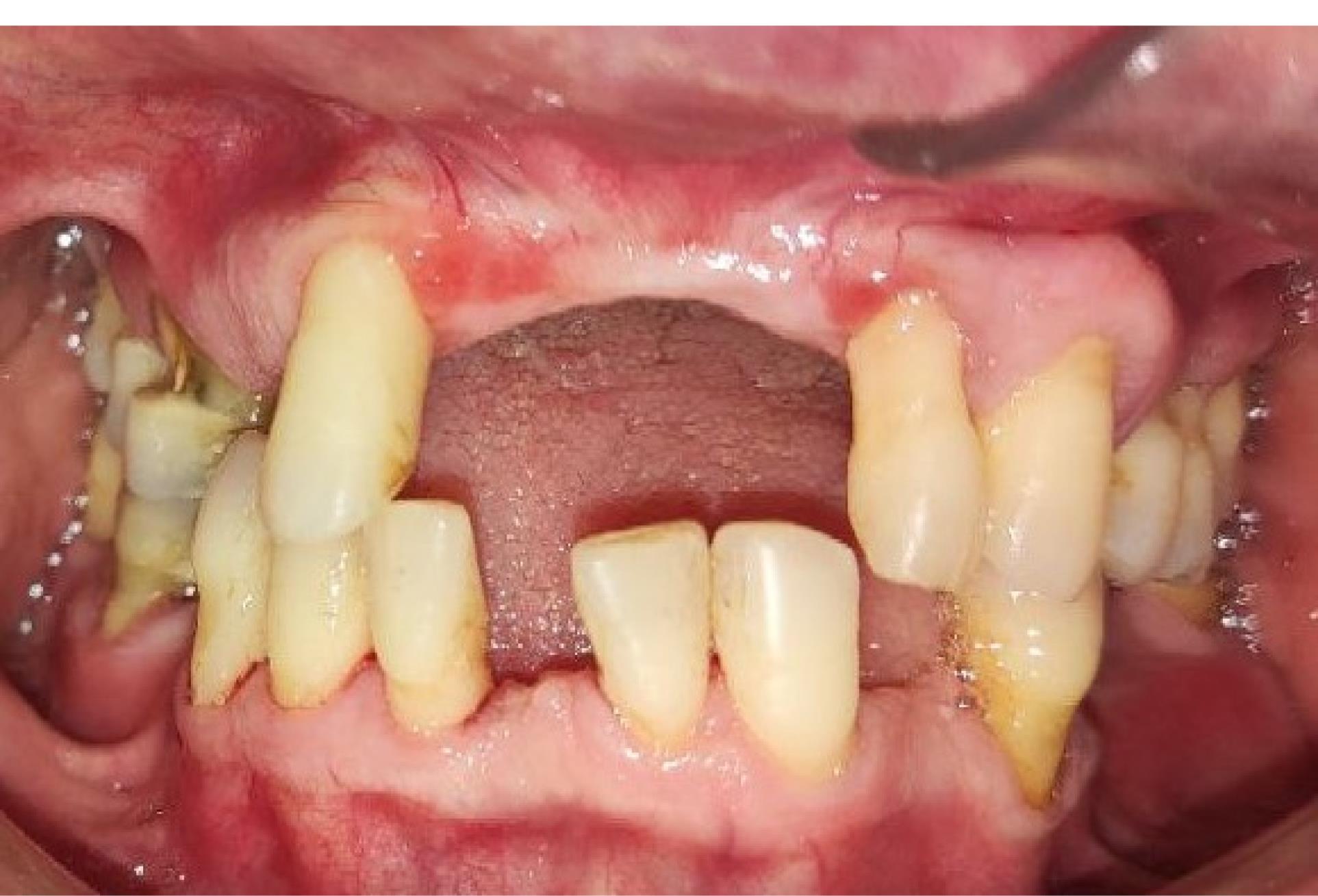Avicenna J Dent Res. 15(4):189-191.
doi: 10.34172/ajdr.1679
Case Report
Oral Manifestations of Aplastic Anemia: A Case Report
Morad Hedayati Panah 1  , Leila Shahsavand Baghdadi 1, Saeedeh Fatholahi 1, *
, Leila Shahsavand Baghdadi 1, Saeedeh Fatholahi 1, * 
Author information:
1Department of Periodontics, School of Dentistry, Ilam University of Medical Sciences, Ilam, Iran
Abstract
Aplastic anemia (AA) is a rare disease characterized by pancytopenia, susceptibility to infection, and difficulty maintaining hemostasis. Drugs are considered to be one of the most important risk factors associated with AA. Various studies have identified the pharmaceutical agents that may contribute to the development of AA. It is common for patients with severe periodontal disease and AA to experience spontaneous bleeding during brushing in terms of thrombocytopenia, which may further exacerbate dental problems. AA patients require comprehensive periodontal treatment that necessitates collaboration with a hematologist.
Keywords: Aplastic anemia, Hematologic disease, Oral manifestation, Periodontal diseases
Copyright and License Information
© 2023 The Author(s); Published by Hamadan University of Medical Sciences.
This is an open-access article distributed under the terms of the Creative Commons Attribution License (
http://creativecommons.org/licenses/by/4.0), which permits unrestricted use, distribution, and reproduction in any medium provided the original work is properly cited.
Please cite this article as follows: Hedayati Panah M, Shahsavand Baghdadi L, Fatholah S. Oral manifestations of aplastic anemia: a case report. Avicenna J Dent Res. 2023; 15(4):189-191. doi:10.34172/ajdr.1679
Background
Hematological diseases may be caused by a variety of processes and etiologies. Red blood cells, white blood cells, platelets, and other types of hematological disorders may all develop from drug use (1). Aplastic anemia (AA), a severe hematologic disorder, is defined by a deficiency of hematopoietic stem cells in the bone marrow, which lowers the quantity of erythrocytes, granulocytes, and platelets (i.e., pancytopenia). Neutrophil levels of fewer than 500/µL and platelet counts of less than 20 000/µL are frequent in patients with severe AA. Although the condition is more common in Asia and other poor countries, it is uncommon in Western countries, with an estimated frequency of 2 cases per million people (2). There is no known cause for around 50% of instances of AA; however, several drugs, benzene exposure, pesticides, viruses, and hepatitis have been linked to the illness (3). Among the first signs of AA are fatigue, more bruises, epistaxis, and gingival bleeding. Infection-related problems might result from protracted pancytopenia. Bacterial sepsis and fungal infections are the leading causes of mortality in AA patients (4). Although the oral symptoms of AA are often mentioned in clinical reports, little is known about their frequency, risk factors, and importance. Increased susceptibility to infection is brought on by neutropenia, which is brought on by the condition and its treatment, and by thrombocytopenia, which results in bruising and mucosal bleeding; these complications are linked to sepsis and hemorrhage, which are the main causes of death in these patients (5,6). These problems often occur in the oral cavity, and minimizing morbidity and mortality linked to AA requires the early diagnosis and treatment of oral lesions (6). Antibiotics known as cephalosporins are often used to treat infections of the skin, soft tissues, respiratory tract, and urinary tract. Patients using cefroxadine have previously been documented to develop AA (7). Side effects are mentioned in the case presentation (gingival ulcer, swollen gingiva). The current study presents a 64-year-old woman who developed AA after cephalexin treatment.
Case Presentation
An Iranian woman in her 64th year made a presentation to the Department of Periodontics at Hamadan University of Medical Sciences. The patient mentioned that she had been experiencing discomfort when eating, a gingival ulcer, and a swollen gingiva for two months. She also documented a number of instances of self-contained gingival hemorrhages. The patient had previously taken Cephalexin for the treatment of cold symptoms. The symptoms were reduced, but a week after the therapy, she started feeling feverish, tired, and hurting. An analysis of the blood revealed neutropenia. The patient had no underlying diseases and had not taken any other drugs in the six months prior to becoming ill. Her white blood cell count, platelet count, and hemoglobin level were 2400/mm3, 18 000/mm3, and 11.4 g/dL, respectively. Hypoplasia was detected in a marrow aspirate, while leukopenia and thrombocytopenia were found in a peripheral blood smear. The drug-induced AA was diagnosed based on the patient’s medical and pharmacological history, as well as the results of clinical and laboratory tests. The patient received the following prescription:
Figures 1 and 2 depict the results of an intraoral examination, which revealed bone necrosis, gingival ulcers, and severe erythematous gingivitis. The results of the radiographic test showed considerable bone loss. Neutropenia in this patient may have been a contributing factor to gingival inflammation. After treatment with immunosuppressive drugs, the patient underwent a regular hematological examination. In the last hematological finding, the blood cell count was normal.

Figure 1.
Bone Necrosis, Gingival Ulcers, and Severe Erythematous Gingivitis
.
Bone Necrosis, Gingival Ulcers, and Severe Erythematous Gingivitis

Figure 2.
Extracted Teeth With Bone Sequester
.
Extracted Teeth With Bone Sequester
Regarding the normal hematologic reviews, the patient received standard oral hygiene instructions. The teeth were extracted since the prognosis for maxillary central incisors was hopeless, and 0.02% chlorhexidine (CHX) mouthwash was topically applied to the gingival lesions. She was informed of the importance of maintaining excellent oral hygiene. The mouthwash of CHX 0.02% was twice a day for one week. The gingival inflammation was resolved following the second appointment, one month later. After six months, there was no sign of gingival ulcers or necrotic bone at the dental examination (Figure 3). The following prescription was administered to the patient:
-
Tab prednisolone 5 mg
-
Cap diazole 200 mg
-
Cap cyclosporine 100 mg
-
Cap clindamycin 150 mg
-
Cap fluconazole 100 mg

Figure 3.
Post-clinical Treatment Photograph Demonstrating Resolution in Clinical Symptoms
.
Post-clinical Treatment Photograph Demonstrating Resolution in Clinical Symptoms
Discussion
One of the most significant risk factors for AA is thought to be drug use. AA may arise as a result of pharmacological drugs that have been found in a number of investigations. Avoiding suspicious medicines will reduce the prevalence of AA (8). To counteract drug-induced AA, it is imperative to remove the suspected substance as soon as possible. Supportive therapies for drug-induced AA may include the transfusion of platelets and erythrocytes, as well as the administration of antibiotics and antifungals (9). The two primary therapeutic options are immunosuppressive therapy and allogeneic stem cell transplantation. The medications cyclosporine and antithymocyte globulin may also be used to treat AA (8,10). Among all antibiotics, cephalosporins are the safest. Nevertheless, albeit uncommon, hematological abnormalities, ranging from monocytopenia to pancytopenia, do happen after their therapeutic usage (11). This example demonstrates the possibility of a serious antibiotic-related consequence. This report describes the example of a 64-year-old Iranian woman who took Cephalexin and afterward developed AA. The following example indicates the intraoral symptoms and indications of a potential neutropenia for ex-bone necrosis, gingival ulcers, and severe erythematous gingivitis, which should alert the doctor to the likelihood of a more serious sickness. The relationship between periodontal disease and neutropenia is widely recognized due to the lowered immune response in periodontal tissues as a consequence of periodontal disease. There are no statistics on the prevalence or risk factors for oral symptoms in AA patients. Submucosal hemorrhages, gingival swellings, herpetic lesions, spontaneous gingival bleeding, pallor, and periodontitis have all been documented in earlier case reports (12,13). Rapidly progressing severe periodontitis is associated with cyclic neutropenia, agranulocytosis, and leukocyte adhesion deficiency, among other quantitative and qualitative neutrophil defects (14). The mechanism behind cephalosporin-induced AA is not well understood due to its rarity. In contrast to agranulocytosis, which is most likely brought on by a humoral immunologic response against mature circulating lymphocytes, acquired AA is most likely brought on by a humoral autoimmune response against myeloid stem cells. Pancytopenia and signs of bone marrow failure are caused by CD34 + cells dying as a consequence of a T cell assault on the bone marrow (15,16). Therefore, doctors should use antibiotics more sparingly and only when absolutely required. They should also care for patients who are taking the medication and be aware of this possibly fatal effect.
Conclusion and Recommendations
AA brought on by medication is a potential adverse effect of various medications. There is a chance that different people may have this peculiar response. Clinicians must become aware of this problem and change the way they prescribe medications as a result. The constant evaluation of the effectiveness and safety of pharmaceuticals used in clinical practice should be taught to clinicians. Additionally, it is advised that national pharmacovigilance guidelines and new drug safety regulations be created in this regard.
Authors’ Contribution
Conceptualization: Morad Hedayati Panah.
Data curation: Saeedeh Fatholahi.
Formal analysis: Morad Hedayati Panah.
Funding acquisition: Morad Hedayati Panah.
Investigation: Saeedeh Fatholahi.
Methodology: Saeedeh Fatholahi.
Project administration: Morad Hedayati Panah.
Resources: Saeedeh Fatholahi.
Software: Leila Shahsavand Baghdadi.
Supervision: Saeedeh Fatholahi.
Validation: Leila Shahsavand Baghdadi.
Visualization: Leila Shahsavand Baghdadi.
Writing–original draft: Saeedeh Fatholahi.
Writing–review & editing: Saeedeh Fatholahi.
Competing Interests
The authors have no relevant financial or non-financial interests to disclose. The authors have no financial or proprietary interests in any material discussed in this article.
Data Availability Statement
The complete documentation of participants enrolled in this study belongs to the corresponding author, Saeedeh Fatholahi, and is available only upon reasonable request.
Ethical Approval
Informed consent was acquired from the patient for the publication of this report and any accompanying images of the patient.
Funding
This research received no specific grant from funding agencies in the public, commercial, or not-for-profit sectors.
References
- Traish AM. Post-finasteride syndrome: a surmountable challenge for clinicians. Fertil Steril 2020; 113(1):21-50. doi: 10.1016/j.fertnstert.2019.11.030 [Crossref] [ Google Scholar]
- Fujiwara T. GATA transcription factors: basic principles and related human disorders. Tohoku J Exp Med 2017; 242(2):83-91. doi: 10.1620/tjem.242.83 [Crossref] [ Google Scholar]
- Ishtiaq O, Baqai HZ, Anwer F, Hussain N. Patterns of pancytopenia patients in a general medical ward and a proposed diagnostic approach. J Ayub Med Coll Abbottabad 2004; 16(1):8-13. [ Google Scholar]
- Yoshida N, Kobayashi R, Yabe H, Kosaka Y, Yagasaki H, Watanabe K. First-line treatment for severe aplastic anemia in children: bone marrow transplantation from a matched family donor versus immunosuppressive therapy. Haematologica 2014; 99(12):1784-91. doi: 10.3324/haematol.2014.109355 [Crossref] [ Google Scholar]
- Ramzan M, Yadav SP, Zafar MS, Dinand V, Sachdeva A. Outcome of pediatric acquired aplastic anemia: a developing world experience. Pediatr Hematol Oncol 2014; 31(1):29-38. doi: 10.3109/08880018.2013.807898 [Crossref] [ Google Scholar]
- Prevost R, Feugueur G, Moizan H, Keribin P, Kimakhe J, Veyssiere A. Management of patients with sickle cell disease in oral surgery Literature review and update. J Stomatol Oral Maxillofac Surg 2018; 119(6):493-7. doi: 10.1016/j.jormas.2018.06.010 [Crossref] [ Google Scholar]
- Rajan MB, Budania A, Bohra GK. Ceftriaxone induced aplastic anaemia: a deadfall trap for bone marrow. Br J Clin Pharmacol 2019; 85(8):1850-1. doi: 10.1111/bcp.13957 [Crossref] [ Google Scholar]
- Syed MA, Atta Ur Rahman A, Shah Syed MN, Memon NM. The relationship of drug therapy to aplastic anemia in Pakistan: a hospital-based case control study. Ther Clin Risk Manag 2021; 17:903-8. doi: 10.2147/tcrm.s325742 [Crossref] [ Google Scholar]
- Iqubal A, Syed MA, Haque MM, Najmi AK, Ali J, Haque SE. Effect of nerolidol on cyclophosphamide-induced bone marrow and hematologic toxicity in Swiss albino mice. Exp Hematol 2020; 82:24-32. doi: 10.1016/j.exphem.2020.01.007 [Crossref] [ Google Scholar]
- Zhu Y, Gao Q, Hu J, Liu X, Guan D, Zhang F. Allo-HSCT compared with immunosuppressive therapy for acquired aplastic anemia: a system review and meta-analysis. BMC Immunol 2020; 21(1):10. doi: 10.1186/s12865-020-0340-x [Crossref] [ Google Scholar]
- Han J, Lee H, Lee YS, Bae YJ, Cho YS, Moon HB. Cephalosporin-induced recurrent aplastic anemia. Eur J Clin Pharmacol 2011; 67(3):317-8. doi: 10.1007/s00228-010-0913-3 [Crossref] [ Google Scholar]
- Campos L, Rezende SB, Palma LF, Simões A, Tateno RY, da Silva RL. High-power laser for oral excisional biopsy in an oncologic patient with pancytopenia. Natl J Maxillofac Surg 2022; 13(1):114-6. doi: 10.4103/njms.njms_439_21 [Crossref] [ Google Scholar]
- Sabnis GR, Karnik ND, Sundar U, Adwani S. Gingival enlargement due to cyclosporine A therapy in aplastic anaemia. Indian J Pharmacol 2011; 43(5):613-4. doi: 10.4103/0253-7613.84988 [Crossref] [ Google Scholar]
- Nazir M, Al-Ansari A, Al-Khalifa K, Alhareky M, Gaffar B, Almas K. Global prevalence of periodontal disease and lack of its surveillance. ScientificWorldJournal 2020; 2020:2146160. doi: 10.1155/2020/2146160 [Crossref] [ Google Scholar]
- Townsley DM, Scheinberg P, Winkler T, Desmond R, Dumitriu B, Rios O. Eltrombopag added to standard immunosuppression for aplastic anemia. N Engl J Med 2017; 376(16):1540-50. doi: 10.1056/NEJMoa1613878 [Crossref] [ Google Scholar]
- Van Antwerp E, Koenig ZA, McCarthy R. Modern medical miracle: matched unrelated donor hematopoietic stem cell transplant after aplastic anemia. Cureus 2021; 13(2):e13050. doi: 10.7759/cureus.13050 [Crossref] [ Google Scholar]